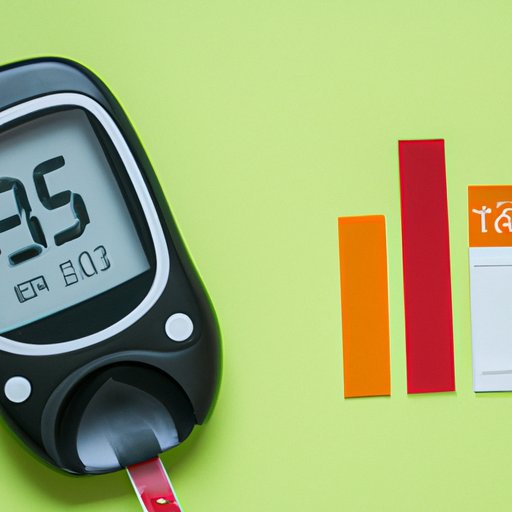Introduction
A1C is a blood test that measures average blood sugar levels over the past three months. A1C, also known as Hemoglobin A1c, is important for managing diabetes and preventing long-term complications. In this article, we’ll explore 10 tips for lowering A1C levels through diet, exercise, medication, blood sugar monitoring, lifestyle changes, and finding a supportive community.
Diet Tips
What you eat has a significant impact on your glucose levels and A1C. Experts recommend eating a balanced diet that’s low in saturated and trans fats, salt, and added sugars. Here are some foods to eat and avoid:
Foods to eat:
- Low glycemic index (GI) foods: These foods release energy slowly, preventing spikes in blood sugar. Examples include whole-grain bread, oatmeal, brown rice, and most fruits and vegetables.
- Foods high in fiber: Fiber slows down digestion and helps regulate blood sugar levels. Examples include beans, lentils, nuts, and seeds.
- Foods high in protein: Protein has a minimal impact on blood sugar levels. Examples include lean meat, fish, eggs, and Greek yogurt.
Foods to avoid:
- Sugar-sweetened beverages: Soda, energy drinks, and sweetened tea and coffee can cause rapid spikes in blood sugar.
- Processed and fried foods: These are often high in calories, carbs, and unhealthy fats.
- Fast food: Burgers, fries, and other fast foods tend to be high in calories, carbs, and unhealthy fats.
Sample meal plan:
- Breakfast: Whole-grain cereal with Greek yogurt and berries
- Lunch: Turkey and avocado sandwich on whole-grain bread with baby carrots and hummus
- Dinner: Grilled chicken, roasted vegetables, and brown rice
- Snacks: Apple slices with almond butter, celery sticks with hummus, or a handful of nuts
Exercise
Regular exercise can help lower blood sugar levels and A1C. Aim for at least 150 minutes of moderate-intensity exercise per week, such as brisk walking, cycling, or swimming. Here are some tips for incorporating physical activity into your daily routine:
- Take the stairs instead of the elevator
- Walk or bike to work, if possible
- Do 10–15 minutes of stretching or weight lifting before bed
- Join a gym, community center, or exercise class
Recommended exercises:
- Aerobic exercise: This includes activities that get your heart rate up, such as brisk walking, jogging, or dancing.
- Strength training: This includes weight lifting, resistance bands, or bodyweight exercises such as push-ups or squats.
- Yoga or Pilates: These exercises can improve flexibility, balance, and coordination.
Medications
If lifestyle changes alone don’t lower A1C enough, medication may be necessary. There are several types of medications for Type 2 diabetes:
- Metformin: This medication lowers the amount of glucose released by the liver and improves insulin sensitivity.
- Sulfonylureas: These medications stimulate the pancreas to release insulin.
- DPP-4 inhibitors: These medications increase insulin production and decrease glucose production in the liver.
- GLP-1 receptor agonists: These medications slow digestion, increase insulin secretion, and decrease glucose production in the liver.
Medications can help lower A1C levels, but they’re not without risks. Possible side effects include diarrhea, nausea, weight gain, and hypoglycemia (low blood sugar). Consult your doctor about the best options for you and the potential risks and benefits.
Blood Sugar Monitoring
Frequent monitoring of blood sugar levels is important for managing diabetes and preventing complications. Here are some tips for monitoring blood sugar levels at home:
- Use a blood glucose meter: This device measures your blood sugar levels from a drop of blood.
- Record your readings: Keep a log of your blood sugar levels to track patterns and show to your doctor.
- Check your A1C: You can get your A1C checked at the doctor’s office every 3–6 months.
The recommended frequency of checking blood sugar levels varies depending on individual needs. Consult your doctor about how often you should check your blood sugar levels.
Lifestyle Changes
In addition to diet and exercise, lifestyle changes like getting enough sleep and reducing stress can help lower A1C levels and improve overall health. Here are some techniques for reducing stress and getting better sleep:
- Practice meditation or deep breathing
- Schedule relaxing activities like reading or taking a bath
- Get at least 7–8 hours of sleep per night
- Avoid screens or stimulating activities before bed
Consult your doctor about any lifestyle changes you’re considering. Small changes can add up to big improvements.
Consult a Doctor
It’s important to consult a doctor before making any major changes to your diabetes management plan. Here are some questions to ask your doctor:
- What’s my A1C level, and what should it be?
- What are the risks and benefits of different types of medications?
- How often should I check my blood sugar levels?
- What lifestyle changes do you recommend?
Working with your doctor can help you make informed decisions about your diabetes management plan.
Support Groups
Managing diabetes can be challenging, but finding a supportive community can make it easier. There are many support groups and resources available, both online and in person. Here are some benefits of joining a support group:
- Sharing experiences and tips with others who understand
- Learning from experts and guest speakers
- Reducing feelings of isolation and stress
Success stories from support groups can be inspiring and motivating. Find a group that meets your needs and schedule.
Conclusion
Lowering A1C levels requires a multi-faceted approach that includes diet, exercise, medication, blood sugar monitoring, lifestyle changes, and finding a supportive community. Taking action now can prevent long-term complications and improve your quality of life. Consult your doctor about the best options for you and make small changes every day. Remember, every little bit counts.
